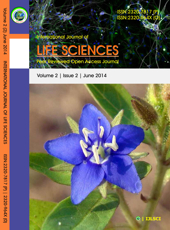Liquid Whey: A Potential Substrate for Single Cell Protein Production from Bacillus subtilis NCIM 2010
Keywords:
Single Cell Protein, Bacillus subtilis, Liquid WheyAbstract
The term single cell protein (SCP) refers to dead, dry cells of micro-organisms. Single Cell Protein production was carried out from liquid whey by using Bacillus subtilis. It was observed that all the whey samples produced the Single Cell Protein (SCP). In the present study, out of the 5 different whey samples, the whey sample-4 has shown high Single Cell Protein production (0.32 mg/ml) followed by whey sample-3 (0.28mg/ml), whey sample-2 (0.24mg/ml) and whey sample-1 and 5 has shown (0.16 mg/ml each) of SCP production. Thus liquid whey can be used for single cell protein production.
Downloads
References
Adedayo MR, Ajiboye EA, Akintunde JK, Odaibo A (2011) Single cell proteins: As nutritional Enhancer. Pelagia research Library, 2(5): 396-409.
Ahmad SH, Aslam MA, Saeed A, Haider A, Anwar A, Sheikh N (2009) Utilization of dairy waste for biomass production of single cell protein through submerged fermentation. Pakistan Journal of Science, 61(2): 60-64.
Anupama, Ravindra P (2000) Value-added food: Single cell protein. Biotechnology Advances, 18(6): 459-479.
Azin M, Moazami N (1989) Production of SCP from sugarcane bagasse. Second Congress of Forest and Technology. Faculty of Engineering. Tehran University, 7(4): 19-21.
Baldasso C, Barros TC, Tessaro IC (2011) Concentration and purification of whey proteins by ultrafiltration. Desalination, 278: 381-386.
De Wit JN (1998) Nutritional and functional characteristics of whey proteins in food products. Journal Dairy Science, 81: 597-608.
Enwefa C (1991) Biomass production from banana skins. Applied Microbiology and Biotechnology, 36(2): 283-284.
Ghanem KM (1992) Single cell protein production from beet pulp by mixed culture. Microbiologia, 8(1): 39-43.
Gunasekaran S, Ko S, Xiao L (2007) Use of whey proteins for encapsulation and controlled delivery applications. Journal of Food Engineering, 83: 31–40.
Huei-hsiung Y (1976) Reduction of nucleic acid in single cell protein by an endogenous polynucleotide phosphorylase. Ph.D. Thesis, Texas Tech. University.
Jelen P (2003) Whey processing. In Production of betagalactosidase from Streptococcus thermophiles grown in whey, Eds., Roginski, H., Fuquay, J.W. and Fox, P.F. Encyclopedia of dairy sciences: London Academic Press, pp. 2739-2751.
Kamel BS (1979) Dates as a potential substrate for single cell protein production. Enzyme and Microbial Technology, 1(3): 180-182.
Khan M, Khan SS, Ahmed Z, Tanveer A (2010) Production of single cell protein from Saccharomyces cerevisiae by utilizing fruit wastes. Nanobiotechnica Universale, 1(2): 127-132.
Kim JH, Libuchi S, Lebeault JM (1981) Protein production from whey using Penicilliun cyclopum: growth parameters and cellular composition. Europine Journal Application Microbiol Biotechnology, 13:151-154.
Koller M, Bona R, Braunegg G, Hermann C, Horvat P, Kroutil M, Martinz J, Neto J, Pereira L, Varila P (2005) Production of polyhydroxyalkanoates from agricultural waste and surplus materials. Biomacromolecules, 6: 561-565.
Lowry OH, Rosebrough NJ, Farr AL, Randall KJ (1951). Protein measurement with the Follin phenol reagent. J. Biol. Chem., 193: 265-275.
Marshall K (2004) Therapeutic applications of whey protein. Altern Med Rev, 9(2): 136-156.
Moharib SA (2003) Utilization of guava peel waste as substrate for protein and protease production by Saccharomyces cerevisiae. Advances in food sciences, 25(2):49-55.
Omar S, Sabry S (1991) Microbial biomass and protein production from whey. Journal of Islamic World Academy of Sciences, 4(2): 170-172.
Panesar PS, Kennedy JF, Gandhi DN, Bunko K (2007) Bioutilisation of whey for lactic acid production. Food Chemistry, 105: 1-14.
Patel GS (1995) The DNA- protein cross: a method for detecting specific DNA- protein complex in crude mixture. Indian Journal of Agricultural Research, 3: 114-134.
Reed G, Nagodawithana T (1995) Method for the preparation of a yeast extract, its use as a food flavor and a food composition comprising the yeast extract. Biotechnology enzymes, biomass, food and feed, Bibliographic Citation, 9: 168-215.
Siso MIG (1996) The biotechnological utilization of cheese whey: A review. Bioresource Technology, 57(1): 1-11.
Spalatelu C (2012) Biotechnological valorization of whey. Innovative Romanian Food Biotechnology, 10: 1-8.
Ware SA (1977) Single cell protein and other food recovery technologies from waste. Municipal environment research laboratory, Office of R and D. U S. E.P.A Cincinnati, Ohio 45268.
Downloads
Published
How to Cite
Issue
Section
License
Copyright (c) 2014 Authors

This work is licensed under a Creative Commons Attribution-NonCommercial-NoDerivatives 4.0 International License.
Open Access This article is licensed under a Creative Commons Attribution 4.0 International License, which permits use, sharing, adaptation, distribution and reproduction in any medium or format, as long as you give appropriate credit to the original author(s) and the source, provide a link to the Creative Commons license, and indicate if changes were made. The images or other third party material in this article are included in the article’s Creative Commons license unless indicated otherwise in a credit line to the material. If the material is not included in the article’s Creative Commons license and your intended use is not permitted by statutory regulation or exceeds the permitted use, you will need to obtain permission directly from the copyright holder. To view a copy of this license, visit http://creativecommons.org/ licenses/by/4.0/











